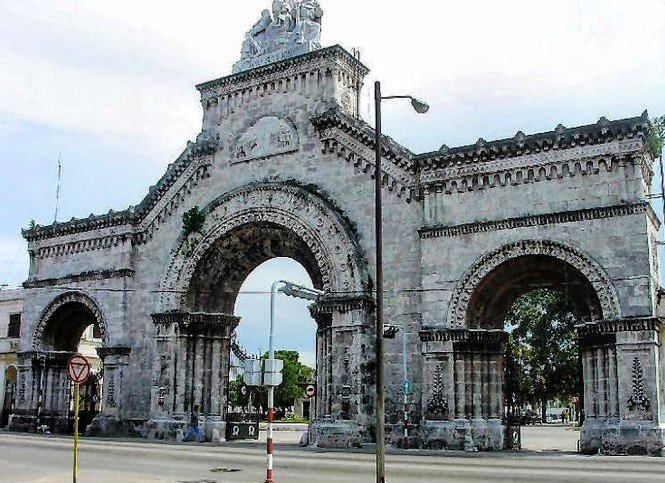
In a previous post
https://ecency.com/hive-163772/@gaviotawriter/a-visit-to-the-palacio
, I told you about my connection to cemeteries and funerary art. This is what finally inspired me to visit Colon Cemetery in Havana. This place impressed me in many ways. But I must say that, despite its fame and magnificence, not all impressions were positive as one might expect. Therefore, this post will talk about the lights of Colon Cemetery: the good, the noteworthy. The rest… in the next post.
The History of Colon Cemetery
Despite what some sources indicate, Colon is not the largest cemetery in the Americas. Its surface area is 56 hectares (0.56 km²). At least in terms of size, others are larger. However, it is one of the cemeteries with the highest density of monumental and historical burials in the world. It houses more than 500,000 tombs and niches (some sources claim up to 800,000, but 500,000 is the most widely accepted official figure). It is estimated that more than 1 million burials have taken place throughout its history.
Furthermore, it has a perfect grid design (straight streets, numbered blocks or "cuadros"), filled with mausoleums, family vaults, and statues of great artistic value, making it one of the largest monumental necropolises on the planet. It is this density, sculptural richness, and historical-artistic value that make it unique and give it its fame as a "giant." It was declared a National Monument of Cuba in 1987, although one of its curiosities is that the North Gate or main entrance, of extraordinary artistic value, received this designation before the cemetery itself. I find some discrepancies in the sources regarding its history; I will try to be as rigorous as possible.
Apparently, it became necessary to replace Espada Cemetery (which I discussed in the aforementioned previous post), which could no longer accommodate a population the size of Havana's. In 1858, it was decided to build this cemetery, but the project didn't get underway until 1866. As late as 1869, it was still just the project and land acquisition. But then, the cholera epidemic of 1868 broke out. People needed to be buried, and there was nowhere to put them. While the paperwork shuffled back and forth, an emergency cemetery called San Antonio Chiquito was set up. In 1870, a competition was opened to choose the best design for the cemetery. It was won by the architect Calixto de Loira, who never even saw it finished, as he died in 1872 (there's a marble plaque marking where he was buried). Construction finally began in 1871 and wasn't completed until 1886.
The first person officially buried in Colon Cemetery was named María de Regla Mustelier García. Specifically, she was buried on October 30, 1871 (the same day as the initial blessing and laying of the cornerstone). She was a free mixed-race woman ("parda libre"), wife of Spanish citizen José Ramón Martínez. She died a victim of the cholera ravaging the city, and her burial was free, authorized by the Civil Governor General due to the sanitary emergency and as a gesture to mark the start of the cemetery's use. She was buried in a common grave.
Another source indicates that it was actually Manuela Balido, a "22-year-old black enslaved woman" who also died of cholera. This appears in some journalistic sources or oral accounts, but is not supported by the cemetery's official documents. It may arise from confusion with another early grave, as hundreds of mass burials took place in the first months (1871-1872) due to the epidemic. According to the archives of Colon Cemetery itself and rigorous historical studies (like those of Eusebio Leal), María de Regla is recorded as the first person buried. Now, although María de Regla was the first, her tomb was not monumental. The oldest tomb that still preserves its original monument also dates from 1871 and belongs to Joaquina Catalina de Zayas y Cisneros (buried on November 4, 1871).
The Art in Colon
Here, the cemetery is truly a marvel. The North Gate or main entrance is a work of art, 20m high by 30m wide. It has beautiful reliefs and a sculpture right at the top representing the three theological virtues: Faith, Hope, and Charity.
At the very center of the cemetery rises the beautiful Central Chapel, something my city's cemetery (also glorious and a heritage site) doesn't have.
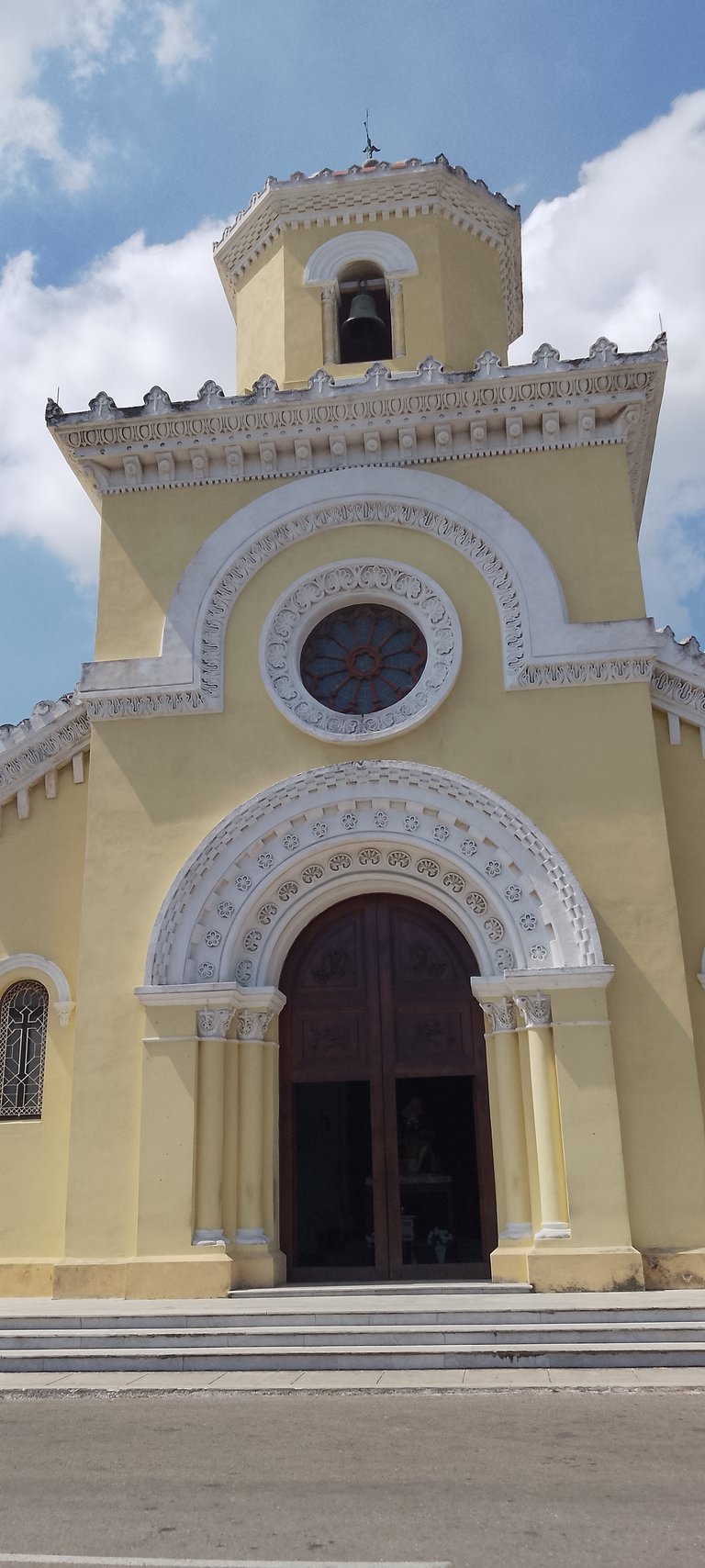
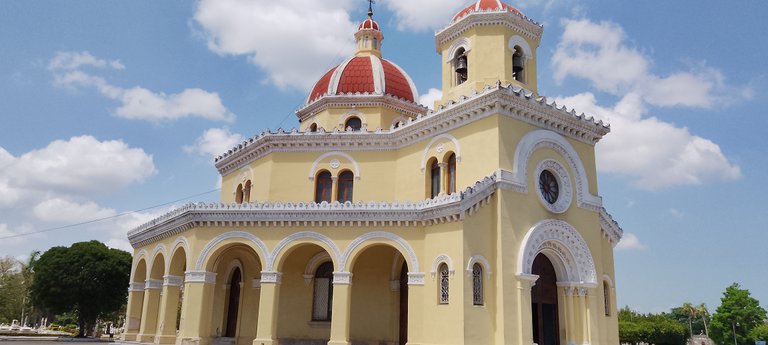
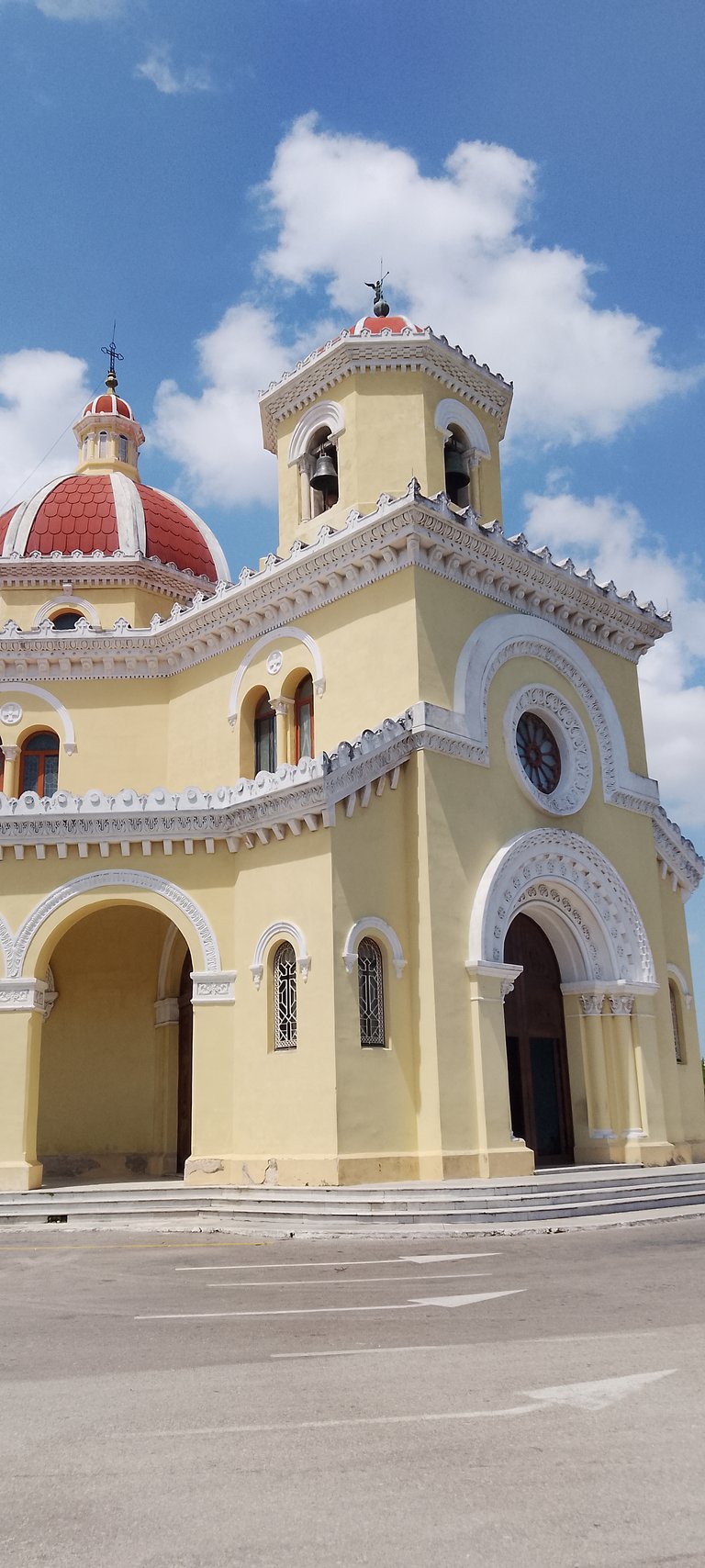
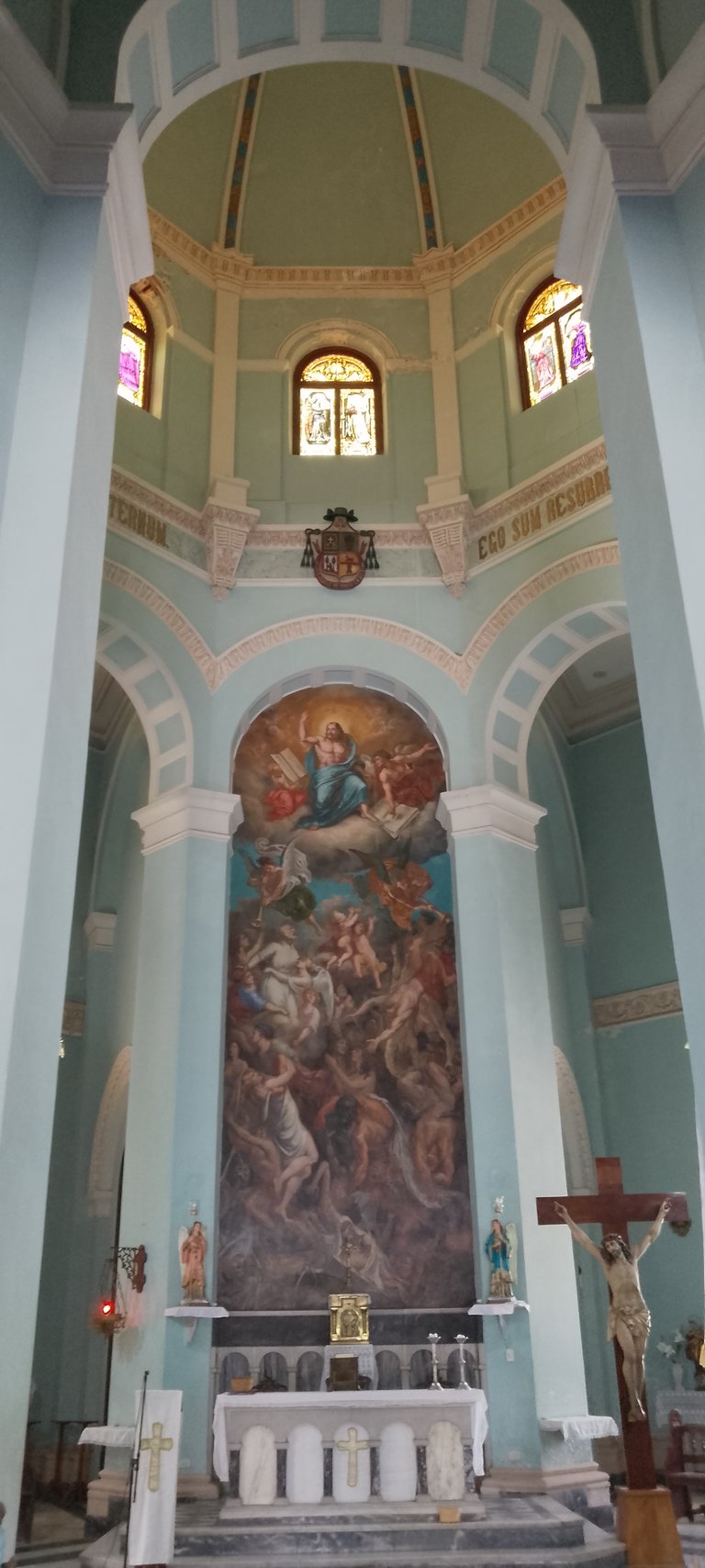

From there and in all directions, the cemetery has what one would expect: crosses, saints, angels, broken columns (symbolizing a life cut short), virgins, representations of The Pietà, and countless marble headstones.

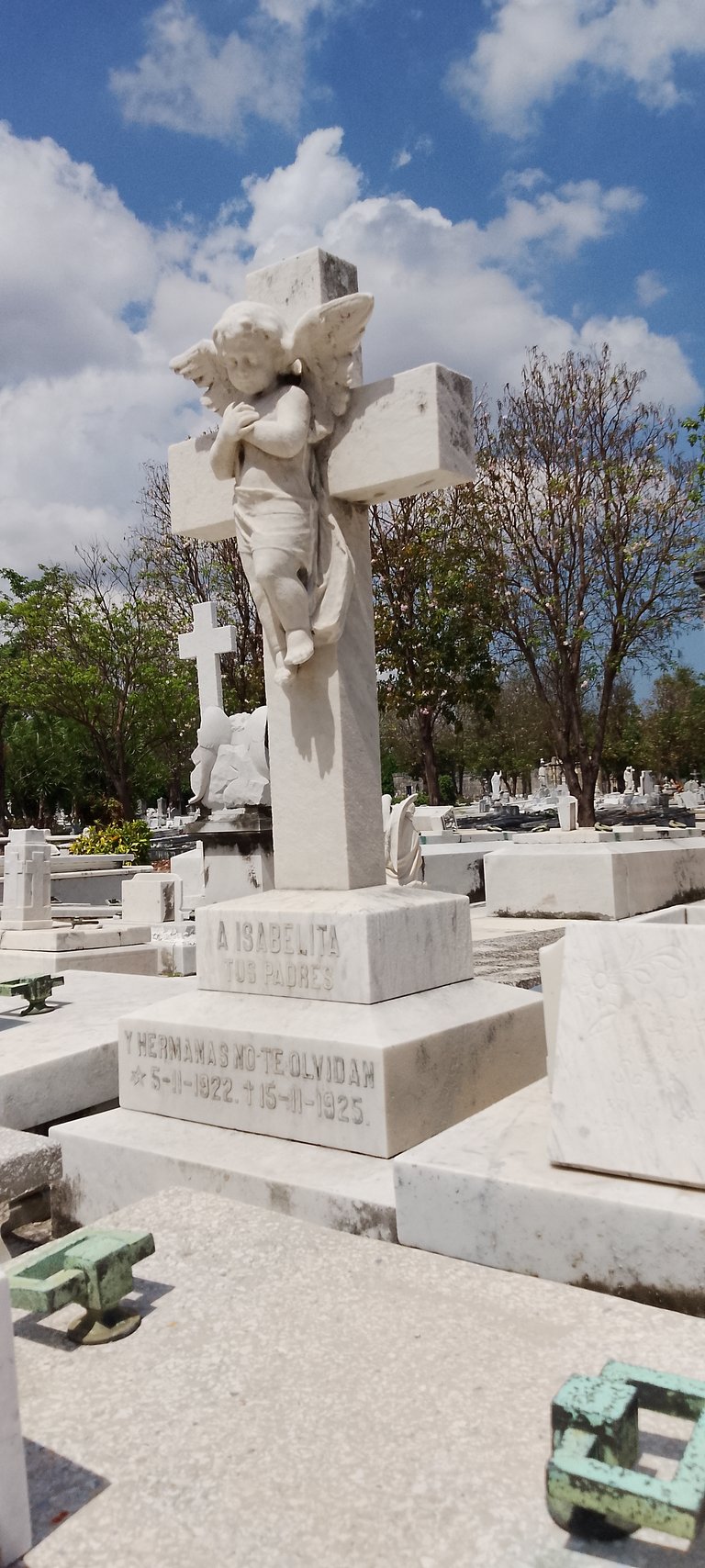
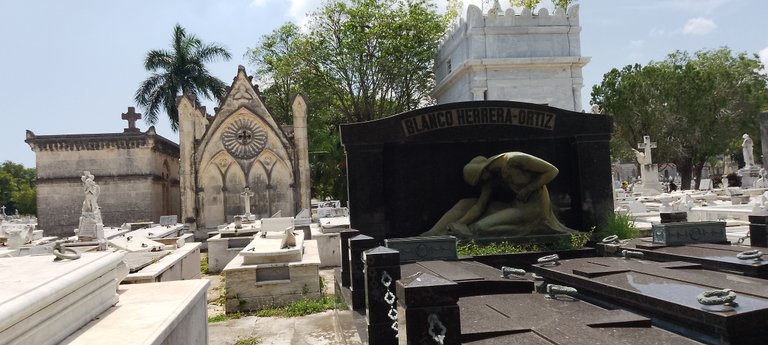
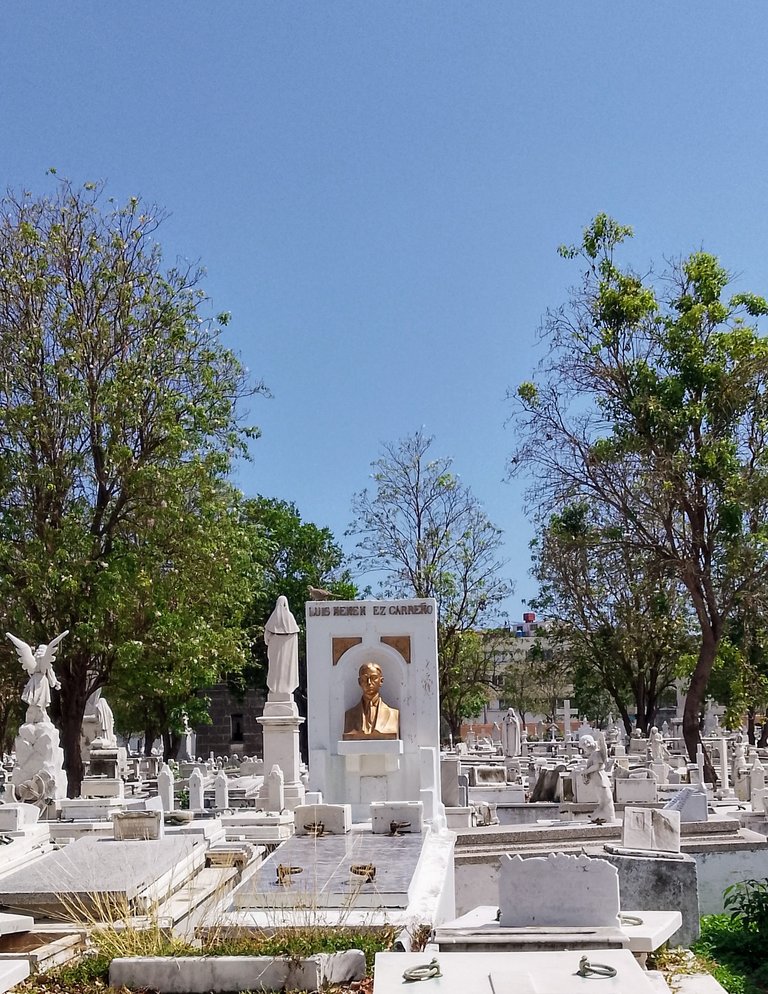
One of the things that struck me the most was the marble itself; I come from Santa Ifigenia, which is practically a white cemetery with some light gray touches, but here the marble is white, pink, brown, gray, black – there's everything. Beautiful.
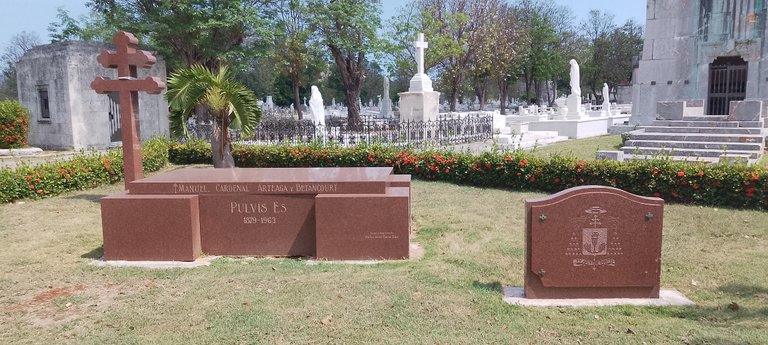

Then I started noticing the differences: the luxurious family vaults. In my hometown, there are many vaults and tombs with beautiful art, but in Colon, there are veritable palaces for the dead. Not all are well-preserved, but all are glorious. The doors, in particular, are beautiful; some have stained glass, and the artistic styles are tremendously varied. Let's try to identify them – my Art History knowledge is a bit rusty.
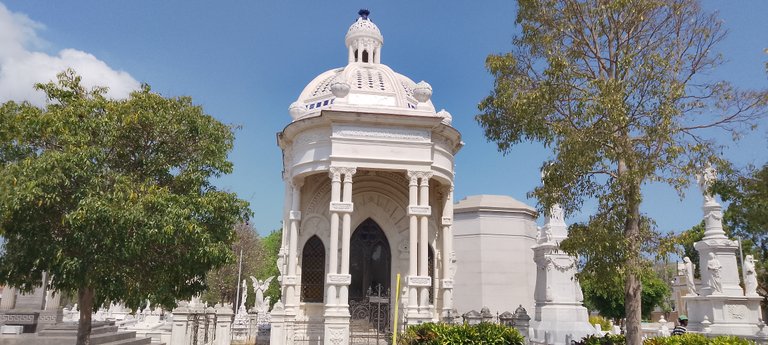

Eclectic. There's a lot of this. Eclectic is like a mix of everything the architect could think of that somehow creates harmony and looks good. Not my favorite, but it's the most common.
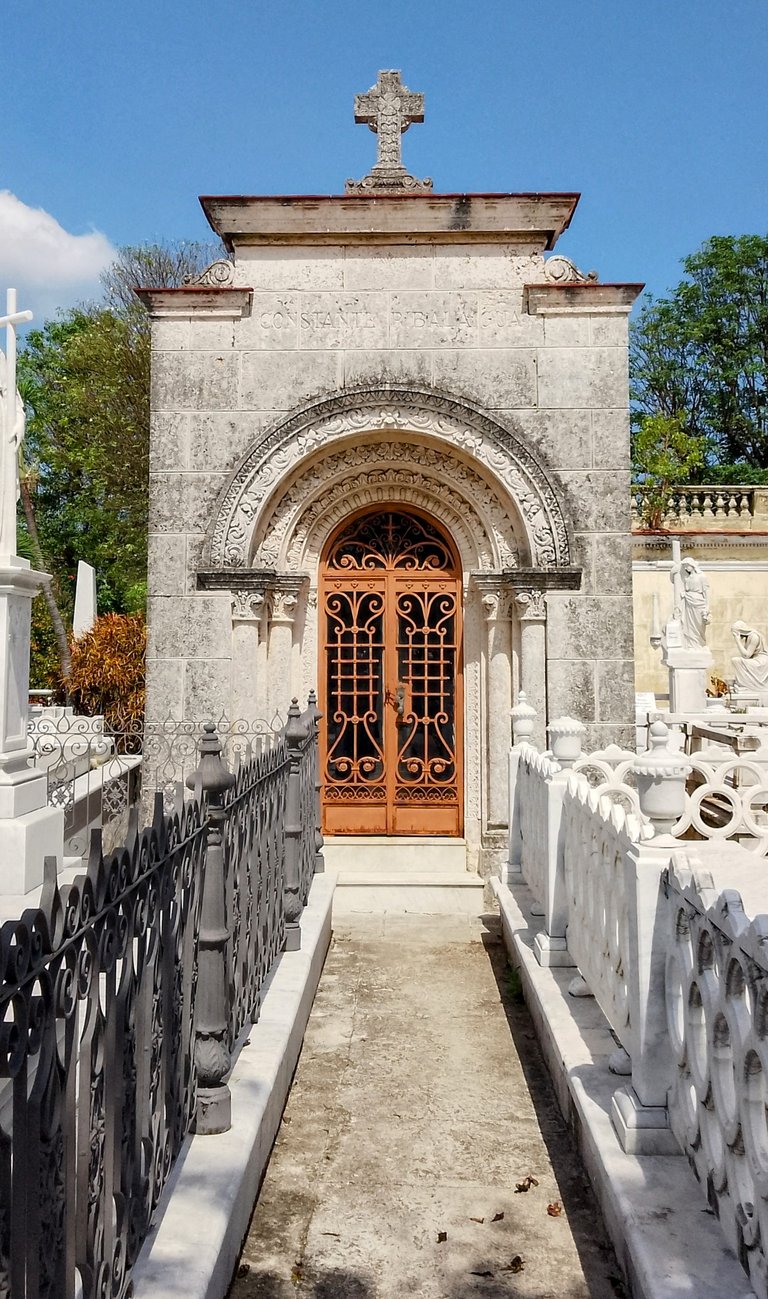

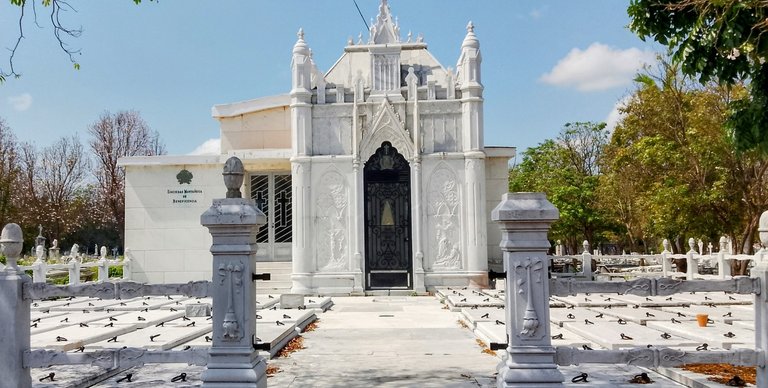
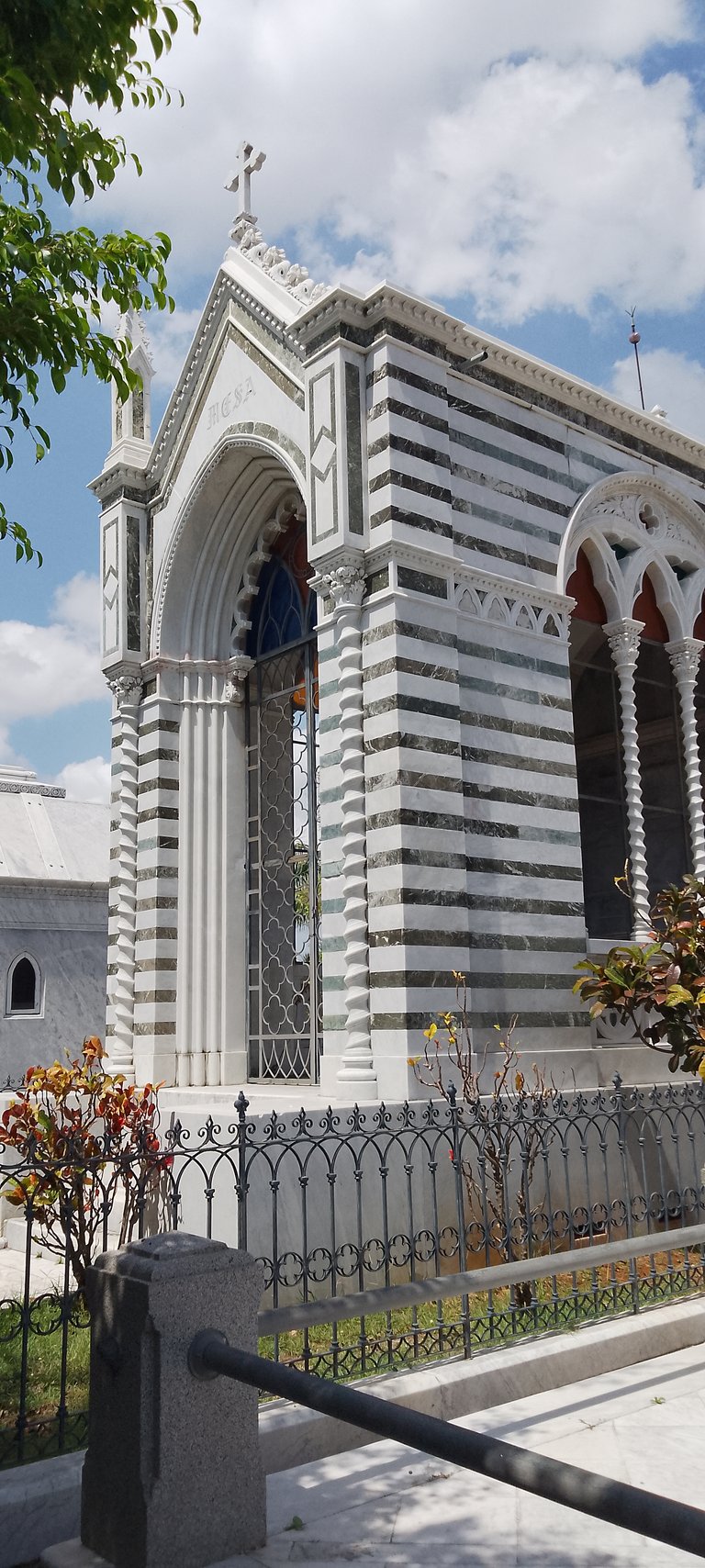
Greek. I don't like it at all, but it has its art, I suppose. I only saw one, didn't take pictures. Neoclassical. I like it as much as Greek: little to nothing.
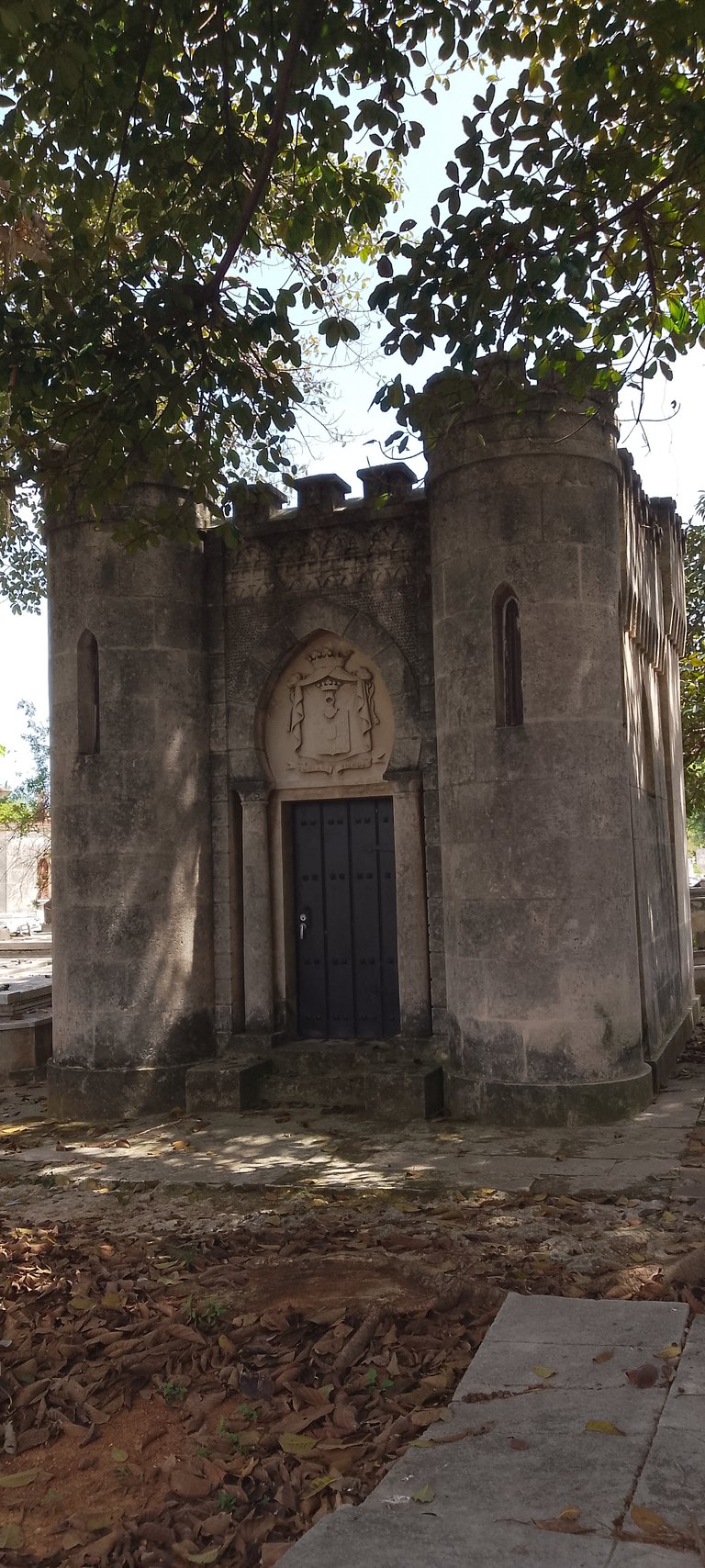
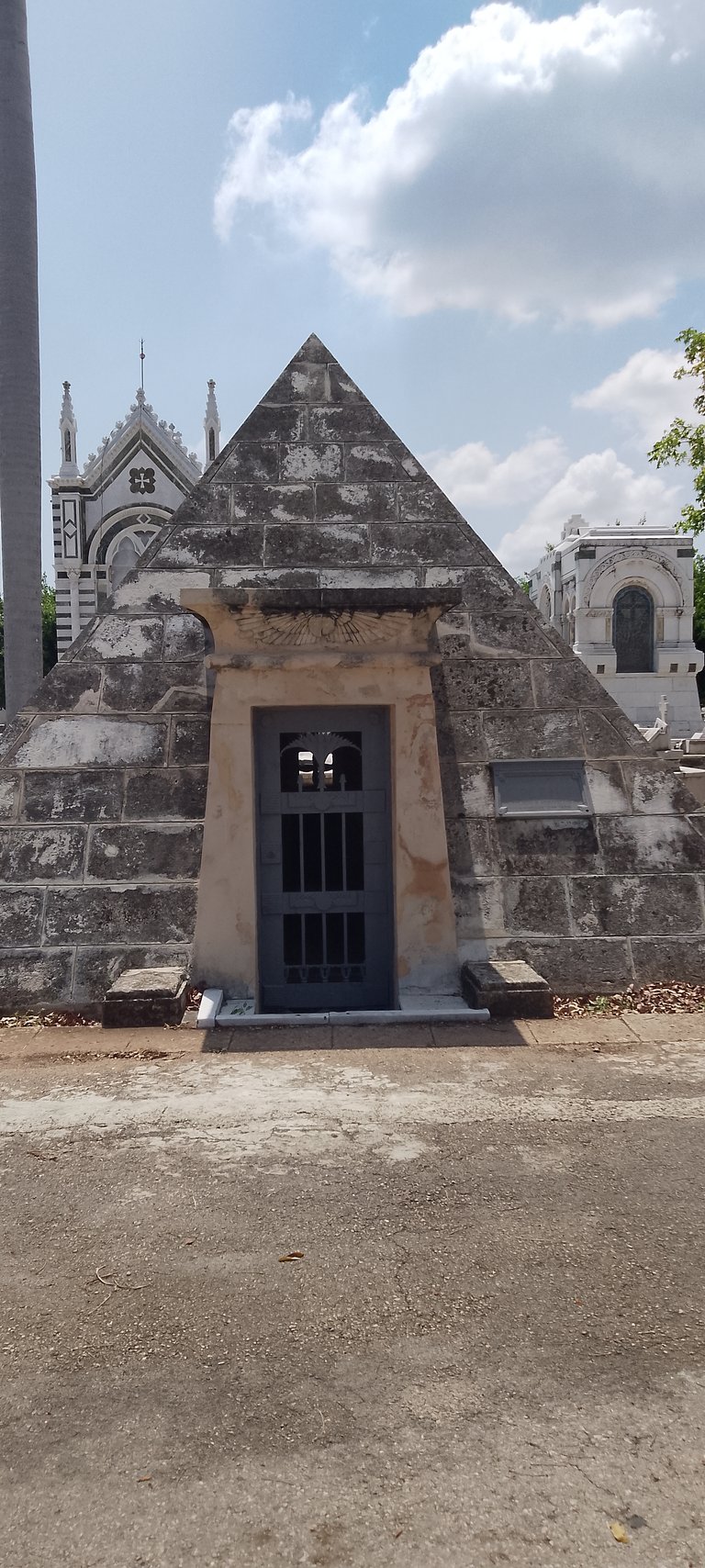
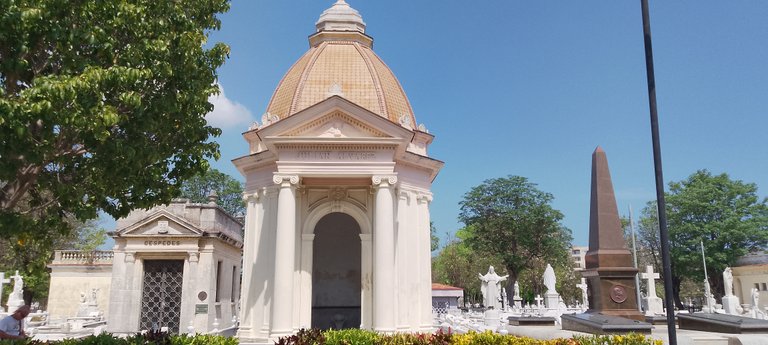
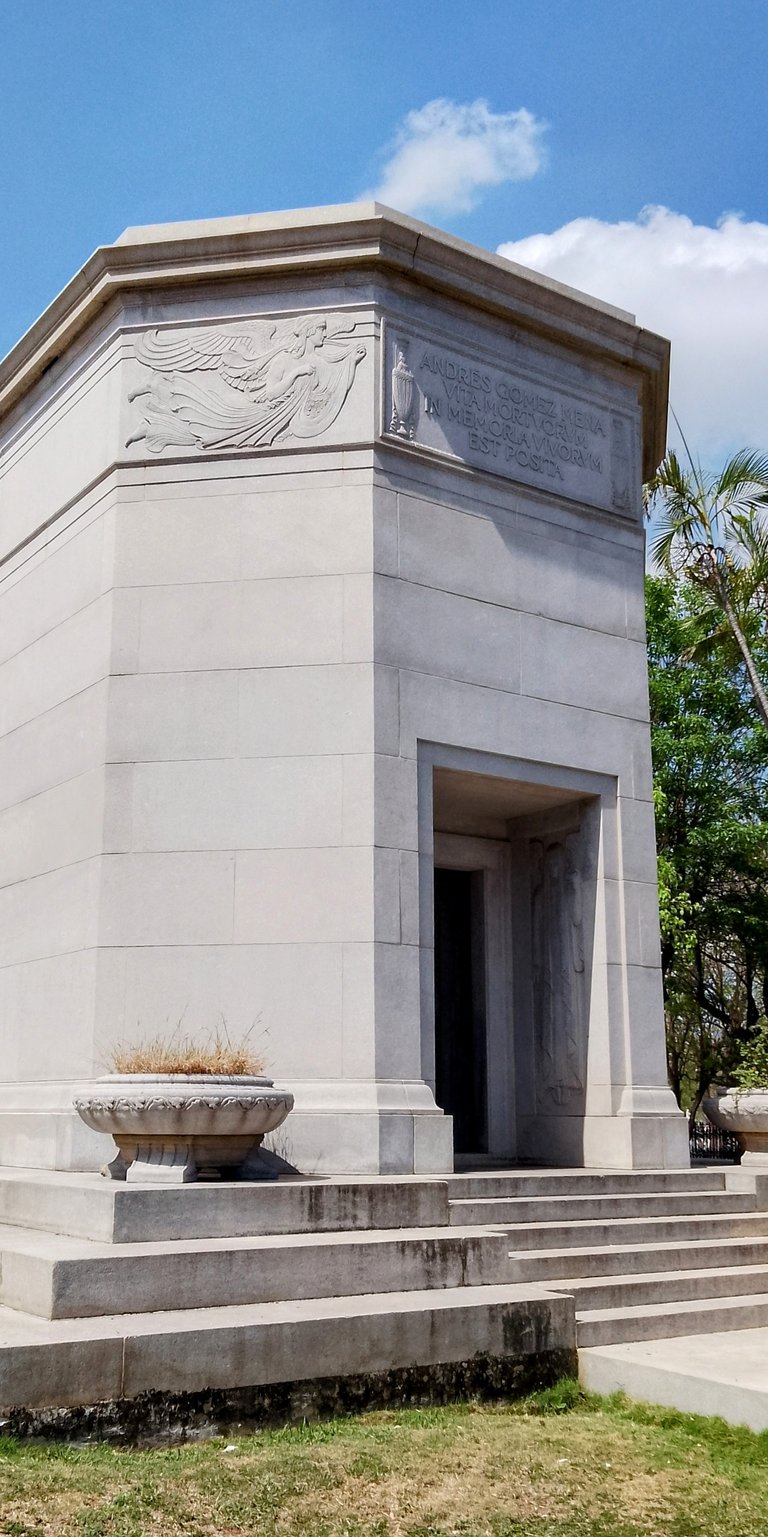
Rationalist and Modern. I like them just enough.
Curiosities I Managed to See
The tomb of José Martí's parents (José Martí is Cuba's National Hero). Martí himself, by the way, is back home, in Santa Ifigenia Cemetery.
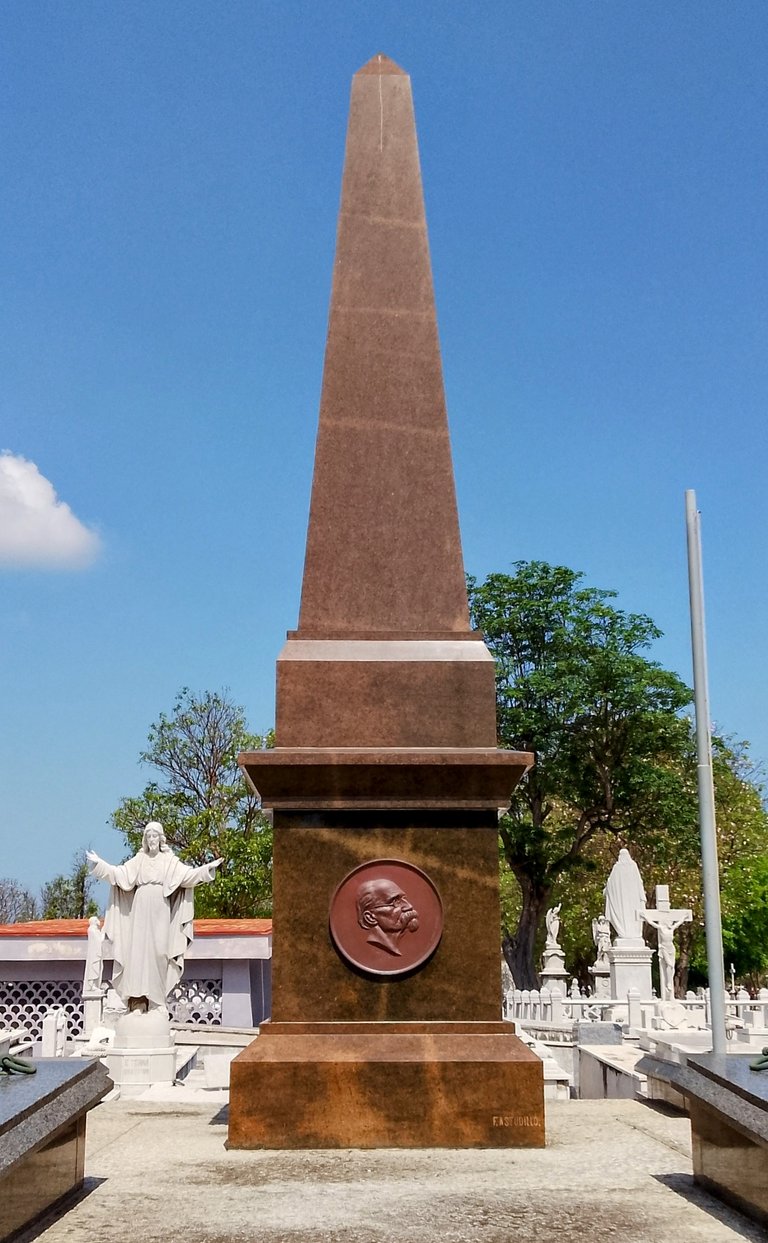
Here lies Máximo Gómez, the Generalisimo. Although born and raised in the Dominican Republic, he is one of the greatest heroes in Cuban history. I found it amusing that his tomb has no name, but any Cuban would recognize that face anywhere.
The tomb of La Milagrosa (The Miraculous One), whom I talked about in another post. People ask her for wishes and bring her offerings.
A vault that looks small but has at least three levels underground. It's enormous. Combatants from several of our country's wars are buried there.
The doggies sleeping in the shade o9f the tombs. I love them, so sweet.
In short, I recommend going. Regarding the state of conservation and not-so-nice things you might see… wait for the next post, the one about the shadows.


En un
https://ecency.com/hive-163772/@gaviotawriter/a-visit-to-the-palacio
, les comentaba de mi conexión con los cementerios y las artes funerarias. Esto es lo que me inspiró para, finalmente, visitar el Cementerio de Colón, en La Habana. Este lugar me impresionó en muchos sentidos. Pero debo decir que, pesar de su fama y magnificencia, no todos positivos como cabría esperar. Por eso, este post hablará de las luces del cementerio de Colón: lo bueno, lo reseñable. El resto… en el próximo.
La Historia del Cementerio de Colón
A pesar de lo que algunas fuentes indican, Colón no es el cementerio más grande de América. Su extensión superficial es de 56 hectáreas (0.56 km²). Al menos por ahí otros le ganan. Sin embargo, sí es uno de los cementerios con mayor densidad de enterramientos monumentales e históricos del mundo. Alberga más de 500,000 tumbas y nichos (algunas fuentes llegan a 800,000, pero 500,000 es la cifra más aceptada oficialmente). Se estima que se han realizado más de 1 millón de enterramientos en su historia.
Además, tiene un diseño de cuadrícula perfecta (calles rectas, manzanas o "cuadros" numerados), repletas de mausoleos, panteones y estatuas de gran valor artístico, convirtiéndolo en una de las mayores necrópolis monumentales del planeta. Es esta densidad, riqueza escultórica y valor histórico-artístico lo que lo hace único y le da fama de "gigante". Fue declarado Monumento Nacional de Cuba en 1987, aunque una de sus curiosidades reflejan que la Puerta Norte o entrada principal, de extraordinario valor artístico, lo fue antes que el propio cementerio. Sobre su historia encuentro cierta discrepancia en las fuentes, intentaré ser lo más rigurosa posible.
Aparentemente, se hizo necesario sustituir el Cementerio de Espada (del cual hablé en el post anterior antes mencionado), que ya no daba abasto para una población como la habanera. En 1858, se decidió construir este camposanto, pero el proyecto solo echaría a andar en 1866. Hasta 1869 todavía era solo el proyecto y la adquisición de los terrenos. Pero entonces, estalló la epidemia de cólera morbo de 1868. Había que enterrar a la gente y no había dónde. En lo que el palo iba y venía, se habilitó un cementerio de emergencia llamado San Antonio Chiquito. En 1870, se abre un concurso para elegir el mejor diseño para el camposanto. Lo ganó el arquitecto Calixto de Loira, quien ni siquiera lo pudo ver terminado, pues murió en 1872 (hay una lápida de mármol en el lugar donde fue sepultado). En 1871 empieza (al fin!) la construcción, que solo terminó en 1886.
La primera persona en ser enterrada oficialmente en el Cementerio de Colón se llamó María de Regla Mustelier García. Específicamente se la enterró el 30 de octubre de 1871 (el mismo día de la bendición inicial y primera piedra). Era una parda libre, esposa del ciudadano español José Ramón Martínez. Falleció víctima del cólera que asolaba la ciudad, y su entierro fue gratuito, autorizado por el Gobernador Superior Civil, debido a la urgencia sanitaria y como gesto para marcar el inicio del uso del cementerio. Fue enterrada en una fosa común.
Otra fuente indica que en realidad fue Manuela Balido, una "negra esclava de 22 años" que también murió de cólera. Esto aparece en algunas fuentes periodísticas o relatos orales, pero no está respaldada por documentos oficiales del cementerio. Es posible que surja de la confusión con otra fosa temprana, pues producto de la epidemia, en los primeros meses (1871-1872) hubo cientos de enterramientos masivos. Según archivos del propio Cementerio de Colón y estudios históricos rigurosos (como los de Eusebio Leal), María de Regla figura como la primera persona enterrada. Ahora bien, aunque María de Regla fue la primera, su tumba no era monumental. La tumba más antigua que aún se conserva con su monumento original data también de 1871 y pertenece a Joaquina Catalina de Zayas y Cisneros (enterrada el 4 de noviembre de 1871).
El arte en Colón
Aquí sí que el cementerio es una maravilla. La Puerta Norte o entrada principal es una obra de arte de 20m de altura por 30 de extensión. Tiene hermosos relieves y una escultura justo arriba que representa las tres virtudes teologales: Fe, Esperanza y Caridad.
Al mismo centro del camposanto, se alza la preciosa Capilla Central, algo que el cementerio de mi ciudad (también patrimonial y glorioso) no tiene.
A partir de ahí y hacia todas direcciones, el cementerio tiene lo que uno esperaría: cruces, santos, ángeles, columnas truncas (que simbolizan la vida truncada), vírgenes, representaciones de La Pietá y muchísimas lápidas de mármol. Una de las cosas que más me llamó la atención fue el mármol per se, yo vengo de Santa Ifigenia que es prácticamente un cementerio blanco con algunos toques de gris claro, pero acá e mármol es blanco, rosado, marrón, gris, negro, hay de todo. Hermoso.
Luego empiezo a ver las diferencias: los lujosos panteones. En mi ciudad natal hay muchas bóvedas y tumbas con arte hermoso, pero en Colón hay verdaderos palacetes para los muertos. No todos están bien conservados, pero todos son gloriosos. Las puertas en particular son hermosas, algunos tienen vitrales, y los estilos artísticos son tremendamente variados. Intentemos identificarlos, que yo en Historia del Arte andaba medio mal.
Ecléctico. Hay mucho de esto. El ecléctico es como la mezcla de todo lo que se le ocurra al arquitecto que de alguna manera crea armonía y queda bien. No es mi favorito, pero es el que más hay.
Románico. Esto no esperé verlo. Es sólido, contundente, sustancial. Bastante gris. Me gusta bastante.
Gótico. Este me gusta, y mucho. No esperé ver tumbas góticas, pero luego lo pienso y La Habana tiene iglesias con este estilo, mi ciudad no, así que tiene lógica.
Griego. No me gusta para nada, pero tiene su arte, supongo. Solo vi una, no hice fotos. Neoclásico. Me gusta tanto como el griego: de poco a nada.
Militar. Esto fue muy interesante. ¡Este panteón es un castillito! Amé.
Egipcio. Esto es una pirámide, y las columnas también son egipcias, qué tumba tan loca. Me encantó.
Renacentista. Vi bastante de esto. Tiene su encanto.
Art decó. El arte moderno no me hace mucho happy. Había bastante de esto. Muy majestuosas, muy… cuadradas.
Racionalista y moderno. Que me gustan lo justo.
Curiosidades que pude ver
La tumba de los padres de José Martí, el Héroe Nacional de Cuba. Martí, por otro lado, está allá en casa, en el Cementerio de Santa Ifigenia.
Aquí yace Máximo Gómez, el Generalísimo. Aunque nacido y criado en República Dominicana, es uno de los héroes más grandes de la Historia de Cuba. Me hizo gracia que su tumba no tiene nombre, pero esa cara la reconocería cualquier cubano donde fuera.
La tumba de la Milagrosa, de la cual hablé en otro post. La gente le pide deseos y le trae ofrendas.
Un panteón que se ve pequeño pero tiene al menos tres niveles bajo tierra. Es enorme. Están enterrados los combatientes de varias de las guerras de nuestro país.
Los perritos durmiendo a la sombrita. Me encantan, tan tiernos.
En fin, que yo recomiendo ir. Sobre el estado de conservación y cosas no tan lindas que se pueden ver… esperen al próximo post, el de las sombras.
Wow it's really very beautiful and the building has a very cool architecture, what a beautiful burial place. You managed to capture some very pampering photos ❤️🙏Eye
Thanks 🥹
🌿 What a deeply moving and artistically rich exploration of Colon Cemetery! Your descriptions brought the place to life, especially how you identified the variety of architectural styles — from Gothic to Egyptian to Art Deco. The personal reflections and the historical depth made this more than just a travel post; it felt like a cultural journey through time. I look forward to reading “the shadows” in the next part ... Thank you for sharing such thoughtful insight!!! 🙏
Espectaculares fotos de un sitio emblemático de la Habana. Gracias por compartirlo 🙏
Some days ago I visited the main cemetery of my city but it's really smaller than this, by the way you did an excellent post with a great description of the cemetery and this cemetery looks really cool with cool tombs and sculptures and the chapel it's amazing
Hiya, @lauramica here, just swinging by to let you know that this post made it into our Honorable Mentions in Travel Digest #2596.
Your post has been manually curated by the @worldmappin team. If you like what we're doing, please drop by to check out all the rest of today's great posts and consider supporting other authors like yourself and us so we can keep the project going!
Become part of our travel community:
You can check out this post and your own profile on the map. Be part of the Worldmappin Community and join our Discord Channel to get in touch with other travelers, ask questions or just be updated on our latest features.
!BBH
Imagínate con vestido negro con decoraciones negras de encaje, dando un recorrido guiado (quizás en la noche) y hablando de todas las curiosidades y leyendas del cementerio. Seguro es una experiencia que muchos turistas pagarían (o pagan ya) por tener.
Habría que ver cuando fue construida la última de las bóvedas o panteones majestuosos. Apuesto que fue en los primeros años del 60 antes de que la Revolución comenzara con sus logros.
Siete años viviendo en la Habana y nunca entré, tengo que solucionar eso. Preferiblemente antes de que se destruya aun más, vamos a ver si tengo la oportunidad.
!BBH
Apúrate, que ya está muy destruido. En un par de días subo la segunda parte del post: las sombras
🙌
¡Un viaje espectacular y divertido que nos regalas y agradecemos totalmente!